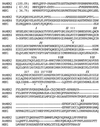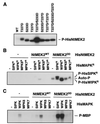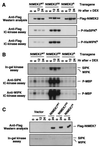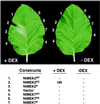Activation of a mitogen-activated protein kinase pathway is involved in disease resistance in tobacco
- PMID: 11209069
- PMCID: PMC14658
- DOI: 10.1073/pnas.98.2.741
Activation of a mitogen-activated protein kinase pathway is involved in disease resistance in tobacco
Abstract
Hypersensitive response (HR), a form of programmed cell death, is frequently associated with plant disease resistance. It has been proposed that mitogen-activated protein kinase (MAPK) cascades regulate HR cell death based on pharmacological studies by using kinase inhibitors. However, direct evidence is lacking. Here, we demonstrate that NtMEK2, a MAPK kinase, is upstream of salicylic acid-induced protein kinase (SIPK) and wounding-induced protein kinase (WIPK), two tobacco MAPKs that are activated by various pathogens or pathogen-derived elicitors. Expression of a constitutively active mutant of NtMEK2 induces HR-like cell death in tobacco, which is preceded by the activation of endogenous SIPK and WIPK. In addition, NtMEK2-SIPK/WIPK cascade appears to control the expression of 3-hydroxy-3-methylglutaryl CoA reductase (HMGR) and l-phenylalanine ammonia lyase (PAL), two defense genes encoding key enzymes in the phytoalexin and salicylic acid biosynthesis pathways. These results demonstrate that a plant MAPK cascade controls multiple defense responses against pathogen invasion.
Figures






Similar articles
-
Function of a mitogen-activated protein kinase pathway in N gene-mediated resistance in tobacco.Plant J. 2003 Feb;33(4):719-31. doi: 10.1046/j.1365-313x.2003.01664.x. Plant J. 2003. PMID: 12609044
-
Activation of salicylic acid-induced protein kinase, a mitogen-activated protein kinase, induces multiple defense responses in tobacco.Plant Cell. 2001 Aug;13(8):1877-89. doi: 10.1105/tpc.010044. Plant Cell. 2001. PMID: 11487699 Free PMC article.
-
Activation of Ntf4, a tobacco mitogen-activated protein kinase, during plant defense response and its involvement in hypersensitive response-like cell death.Plant Physiol. 2006 Aug;141(4):1482-93. doi: 10.1104/pp.106.080697. Epub 2006 Jun 23. Plant Physiol. 2006. PMID: 16798947 Free PMC article.
-
Pathogen-induced MAP kinases in tobacco.Results Probl Cell Differ. 2000;27:65-84. doi: 10.1007/978-3-540-49166-8_6. Results Probl Cell Differ. 2000. PMID: 10533199 Review.
-
Signaling through MAP kinase networks in plants.Arch Biochem Biophys. 2006 Aug 1;452(1):55-68. doi: 10.1016/j.abb.2006.05.001. Epub 2006 May 24. Arch Biochem Biophys. 2006. PMID: 16806044 Review.
Cited by
-
AtALMT9 is a malate-activated vacuolar chloride channel required for stomatal opening in Arabidopsis.Nat Commun. 2013;4:1804. doi: 10.1038/ncomms2815. Nat Commun. 2013. PMID: 23653216 Free PMC article.
-
In silico-prediction of downstream MYB interacting partners of MAPK3 in Arabidopsis.Bioinformation. 2014 Dec 31;10(12):721-5. doi: 10.6026/97320630010721. eCollection 2014. Bioinformation. 2014. PMID: 25670873 Free PMC article.
-
Vacuolar Chloride Fluxes Impact Ion Content and Distribution during Early Salinity Stress.Plant Physiol. 2016 Oct;172(2):1167-1181. doi: 10.1104/pp.16.00183. Epub 2016 Aug 8. Plant Physiol. 2016. PMID: 27503602 Free PMC article.
-
Redox Status, JA and ET Signaling Pathway Regulating Responses to Botrytis cinerea Infection Between the Resistant Cucumber Genotype and Its Susceptible Mutant.Front Plant Sci. 2020 Sep 25;11:559070. doi: 10.3389/fpls.2020.559070. eCollection 2020. Front Plant Sci. 2020. PMID: 33101327 Free PMC article.
-
Mitogen-activated protein kinases and reactive oxygen species signaling in plants.Plant Physiol. 2006 Jun;141(2):351-6. doi: 10.1104/pp.106.079160. Plant Physiol. 2006. PMID: 16760487 Free PMC article. No abstract available.
References
Publication types
MeSH terms
Substances
Associated data
- Actions
LinkOut - more resources
Full Text Sources
Other Literature Sources
Miscellaneous

